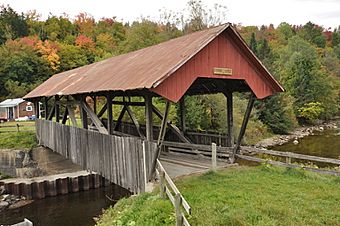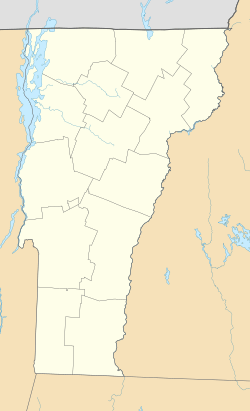Burrington Covered Bridge facts for kids
Quick facts for kids |
|
|
Burrington Covered Bridge
|
|
 |
|
| Location | Adjacent to Burrington Bridge Rd., off VT 114 northeast of Lyndon, Vermont |
|---|---|
| Area | 1 acre (0.40 ha) |
| Architectural style | queenpost truss |
| NRHP reference No. | 74000203 |
| Added to NRHP | June 13, 1974 |
The Burrington Covered Bridge is a really old and special covered bridge located in Lyndon, Vermont. It was built a long time ago in the 1800s. This bridge is one of five historic covered bridges you can find in Lyndon.
The Burrington Covered Bridge used to carry Burrington Bridge Road over the Passumpsic River. Now, a newer bridge handles the traffic. Because of its history, the bridge was added to the National Register of Historic Places in 1974.
Discover the Burrington Covered Bridge
The Burrington Covered Bridge is in a quiet, countryside area. It's just northeast of downtown Lyndon. You can find it south of Vermont Route 114. The Passumpsic River flows nearby. A newer bridge crosses the river just upstream from this historic covered bridge.
How the Bridge is Built
The Burrington Covered Bridge is a single-span bridge. It uses a special design called a queenpost truss. This design helps the bridge support weight. The bridge is about 68 feet (21 m) long. It is also about 15 feet (4.6 m) wide. The part where cars used to drive is 12.5 feet (3.8 m) wide.
The bridge sits on strong supports called abutments. These are made of stone and concrete. A gabled roof covers the bridge. It has wide edges, called eaves. The sides of the bridge have vertical wooden boards. These boards go up about halfway. Inside the bridge, you can see iron rods. These rods help make the truss stronger. The bridge floor is made of wooden planks. The entrances, called portals, stick out a bit. They also have vertical wooden boards. The corners of the portal openings are cut diagonally.
A Look at its History
The Burrington Covered Bridge is one of five covered bridges in Lyndon. All these bridges were built in the 1800s. They share similar features. For example, they all have wide eaves. They also have shortened siding and projecting portals. This bridge was used for traffic until 1965. That's when the new bridge was built nearby.



